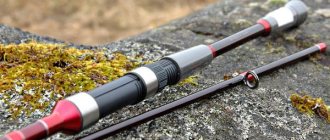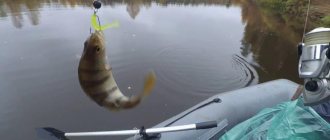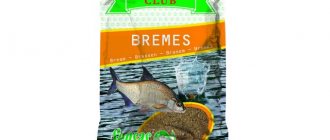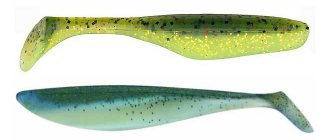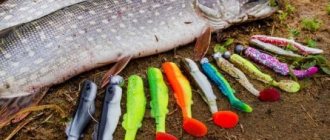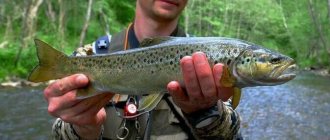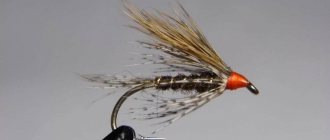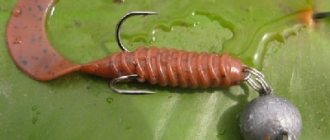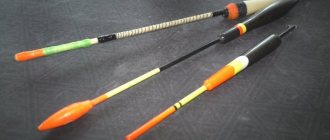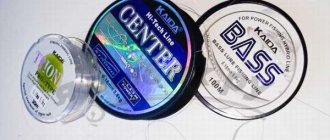Non-hooking lures
The spinnerbait is the best non-snagging bait that benefits from irritating several of the predator’s senses at once.
- Spinnerbaits are unique spinning baits that contain a variety of sources of irritation for insatiable predators (from bright petals swaying under the pressure of water to curly squid tails).
- many other lures equipped with an offset hook that hides the exposed tip
- baits that are equipped with metal rods directed from the beginning of the hook to the tip of its sting
There are actually a lot of non-hooking spinning baits, but at the forefront is the bait, which is primarily considered non-hooking. The spinnerbait is able to pass through thick grass and not get caught; not even a blade of grass remains on the bait.
First of all, non-hooking ones are silicone twisters and vibrating tails, which are equipped with an offset hook. This type of equipment allows you to hide the tip of the hook by slightly deepening it into the silicone, and when a predator strikes and hooks it, the hook will certainly pierce the attacker.
Non-hooking baits are catchy baits when fishing for pike in thick thickets.
Selection of baits depending on the season
Pike fishing can be done all year round, but the characteristics of each season have a tremendous impact on the choice of bait. In order to facilitate this process, the behavior of the predator will be examined in detail by season, which will allow fishermen to choose the right bait.
Spring
Spring fishing is very effective, since the pike begins to eat after the winter hunger strike and now needs to replenish its energy supply.
Fishing features by month are as follows:
- In March, pike usually still remain passive, because the ice has not left the reservoirs or the water simply has not had time to warm up enough. To get a catch, you will have to lure the prey from an impressive depth; for this, small baits with a quick dive are usually used. During March fishing, it is best to use jig baits.
- April fishing largely depends on the climatic conditions of a particular area, but in most cases it is not fundamentally different from fishing in March: pike will have to be lured with a jig from great depths.
- In May, the water warms up and the predator rises closer to the surface of the water , so the jig bait can be safely replaced with floating wobblers or suspenders, which give good results.
To get a catch, you will have to lure prey from an impressive depth; for this, small baits with a quick dive are usually used
Summer
Summer fishing is stable if the main prey is pike. The bite is usually absent only in the hottest weather, when the predator goes to the bottom to hide from the sun's rays.
The selection of baits by month is as follows:
- June is a good period for catching this predator ; it shows a sufficient level of activity and responds well to baits with an aggressive color, especially if you catch it in shallow water.
- In July, the bite decreases slightly due to hot weather ; to get a catch, you need to use bait that is most similar to the fish that are part of the pike’s diet. Since she does not like to chase fast prey during the heat, it is necessary to use only slow wiring.
- The predator's behavior changes around mid-August , when the heat gradually subsides and the fish's appetite awakens. The principles of fishing do not differ from those used in June, but with the onset of cold weather, you will need to look for prey closer to the bottom surface.
Autumn
Autumn fishing is also characterized by good productivity, since the predator needs a fat reserve, which it will need in winter, so it begins to actively feed.
There are the following fishing features by month:
- In September the bite is quite good, but has not yet reached its peak levels. It is best to use baits with fast and significant depth, as the pike begins to sink closer to the bottom surface. An exception can be made only for morning fishing, when a predator rises up to hunt fry.
- In October, sufficiently large wobblers or spinners of the oscillating type can show the greatest effectiveness. Locating the location of prey can be very difficult, since it can sink closer to the bottom or rise to the surface of the water. It is recommended to choose baits that are exclusively dark tones and have a natural color.
- November is the period when most fishermen go looking for pike, as they are one of the few species that continue to bite into the last month of autumn. Jig baits are most effective at this time, and it is best to look for prey at great depths, where it descends after the favorite object of hunting - fry.
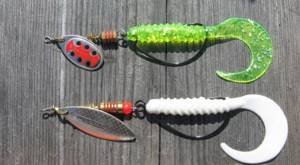
In September, it is best to use baits with fast and significant depth, as the pike begins to sink closer to the bottom surface
Winter
Winter fishing does not have any particular differences between months, so it is enough to give general recommendations, which are as follows:
- After the first ice appears, it is necessary to use baits that do not sink to the bottom, but linger longer in the upper layers of the water.
- A significant role during winter fishing is played not so much by the choice of a specific type of bait as by the discovery of prey sites.
- The periods after ice formation, immediately before it melts , and also during thaws are the most favorable for fishing.
- At the end of winter, you can start using a special type of fishing rod - a zherlitsa, which shows high efficiency when fishing with live bait.
Wobblers
Wobbler is one of the most versatile baits, allowing you to fish both on the surface and in deep water near the bottom.
A detailed guide to the classification of wobblers by type and type.
Wobblers are artificial baits for spinning rods made of plastic, wood, foam, which in their appearance imitate fish and fry. The main feature of the wobbler is the presence of a blade in the bow, which, when retrieved, causes the wobbler to dive. The depth of immersion of the bait when retrieving depends on the angle of inclination of the blade to the fishing line and the size of the blade.
Wobblers differ firstly in buoyancy:
- drowning
- pop-up
- suspenders
And secondly, in terms of depth during wiring:
- superficial (from 0.5 to 1 meter)
- medium-depth (from 1 to 3 meters)
- deep-sea (from 3 meters or more)
Wobblers perform best when fishing for pike, perch, and chub.
There are two more types of wobblers that do not have blades:
Poppers
Poppers - surface baits that create a gurgling sound when pulled, actively catch pike
This is an exclusively surface wobbler. The depth of its penetration is zero. The front part does not have a blade, but instead a cavity (recess) is created with holes on the sides. When pulled with the tip of the rod, the popper creates gurgling sounds, which attracts predators.
The most common hunter for poppers is pike.
Rattlins
Rattlins - deep-sea wobblers without a blade with a rattle inside
These are deep-sea baits made in the shape of flat fish. Like wobblers, they most often have two doubles, but there is no blade - this is their main difference from wobblers. In general, rattlins are called “Lipless Crankbait” - a bladeless bait. It is worth noting the extraordinary game, which very little resembles a fish; nevertheless, this bait, in some cases, catches much more successfully than any less noticeable twister or other jig bait. Many rattlins are equipped with a rattle - this is another plus in the piggy bank.
In deep water, rattlins can be used to successfully catch pike perch, bass, catfish, and perch.
Other lures for pike
The article examined the most popular lures for pike fishing, which have proven themselves on the positive side and are always popular with many fishermen.
But there are other varieties that are often no less effective, they are discussed in more detail below:
- Live bait. Small fish such as gudgeon or roach are best suited for pike fishing. If a predator in a particular body of water is accustomed to hunting other species, then they can also be used to increase the likelihood of a bite. Fishing with live bait has a number of advantages over using artificial bait, the main ones being the attractive natural smell, natural play and unpredictability of bait behavior.
- Using a popper. At its core, it is a subspecies of spinners, which differs in its design features. They consist in the presence of special holes in the surface of the bait, which create a background noise during wiring, which can attract predators to the fishing site even from a very long distance. There is still debate among professional fishermen regarding the usefulness of this effect and its impact on the bite, but many people still note that poppers gave a positive result in a number of cases when other baits did not bring it.
Soft foam fish
A foam fish gives the impression of a sick fish (the tail stands in a vertical position when it falls to the bottom)
Foam rubbers are used as jig baits. Their main property is to raise the tail of the bait to the top due to the good buoyancy of the porous foam, which is filled with air. Thus, the bait resembles a sick fish, which every now and then nods.
For fishing with foam rubber fish, only jig step-by-step bottom wiring is used in order to achieve that same effect of a sick fish.
On the right in the image, the foam rubber fish is equipped with a Cheburashka sinker through the winding ring, as well as an offset hook that will protect the bait from many hooks.
Foam rubbers are catchy baits for catching pike perch, bass, perch, pike, and catfish.
Main types of matrices for filling molds of baits
Today there are only two main types of matrices:
- One-sided.
- Double sided.
One-sided matrices are a structure made of gypsum, which can also be made independently, following the tips and recommendations. To do this, you will definitely need a sample nozzle.
Such a sample is most often made from wood or clay; the finished model must be lubricated with Vaseline to better lag the source material. The technology for making a mold using a matrix is quite simple - you need to fill the matrix with the finished mixture, which is 2 times thicker than the sample.
First of all, you need to carefully immerse the model, and the plaster to a depth that will be slightly more than half of it, and wait a while until it dries completely and slowly remove the sample, leaving a cast. After the matrix is covered with sealant used in construction work, the one-sided matrix will be completely ready.
To make a double-sided matrix with your own hands, you will first need a container; it is best to choose a rectangular or square shape. The selected form must be filled with plaster approximately halfway and only then lower the bait model halfway inside.
For maximum hardening, you need to leave the model in the container for about 10-12 hours and only after that you can begin to fill the second half of the matrix. In this case, it is necessary to pay special attention to the fact that half of the double-sided matrix must be lubricated with grease or petroleum jelly so that they can subsequently be easily separated.
It is recommended to make the solution thin enough so that any bubbles that form can be removed. After the second part of the double-sided matrix has already been placed in the container, it is worth, just like the first time, allowing time for complete drying.
After this, separate the matrices and be sure to pay attention to the presence of burrs, which (if any) should be removed without fail by cleaning the matrices.
After removing the sample, you need to give it a few days for all the elements to dry and set well. When applying construction sealant, it is necessary to take into account the fact that it will only need to cover one part of the matrix.
After all that has been done, you can take on the construction of air vents and sprues with complete confidence. To do this, you need to use a knife or any sharp object that is available to make a small groove from the edge of the mold to the sample itself.
Subsequently, such a groove will need to be processed with a drill. In total, there should be about 8 air outlets in the double-sided matrix, which makes it possible, when used, to make volumetric baits at home. Such baits will closely resemble live fish, which, unfortunately, cannot be achieved using a one-sided matrix.
Soft silicone baits
Guide to fishing with silicone baits.
- twisters
- vibrotails
- crustaceans
- squid
- worms (most often used in drop-shot rigs)

All these baits are used as bottom baits and always in combination with a sinker. The bait can be attached directly to the sinker of the jig head on the hook, or it can be attached using a spaced method (the sinker is separate, and the bait is on a leash separately).
The most common spinning equipment for fishing with silicone baits:
- diverter leash
- drop shot
Silicone baits allow you to catch perch, pike perch, pike perch, pike, and catfish in the bottom zone.
Photos of wobblers
Read here Spinning rod equipment: a description of how to equip and select equipment elements for beginners (120 photos)
Help the project, share on social networks 

0
Fishing lures
- classic oscillating (oscillators) - have the shape of a concave plate, create amplitude low-frequency oscillations, long-range; spoons are most often used when fishing for pike;
- rotating (spinners) - have a rotating petal, which begins to rotate under the influence of water resistance; good turntables begin to rotate with slow wiring and rotate quickly, the higher the rotation speed, the better the quality of the turntable; are catchable when fishing for perch;
- castmasters are the longest-range spinners, in essence they resemble an oscillating spinner, but have a characteristic unique game, castmaster is a very good bait for asp;
- Devons - spinners with a propeller, often heavy and long-range, but require fairly fast reeling to create rotation and oscillations; specialization: perch, asp;
- bladebaits (cicadas) - blade-shaped spinners that have the game of a very mobile insect; They catch perch, pike perch, and pike.

Rating of the best-selling spinning lures and other fishing products at low prices! Readers have already joined in shopping from China on Aliexpress. Join us too.
Description of each type
The majority of silicone baits are twisters and vibrotails, but there are also silicone worms, slugs, crayfish and crawfish, frogs and silicone tubes. Twisters have a smooth or ribbed body with a curled tail. Their peculiarity is that when pulled straight, the tail of the twister oscillates, thereby creating a unique game.
Basics of fishing
Flavoring additives for carp bait
To help the novice fisherman
Twisters are designed for catching active predatory fish. Vibrotail is a type of bait that is very similar in appearance to a real fish. Its tail is located either at an angle or perpendicular to the body. Rubber worms imitate natural worms, but in different colors, lengths and diameters. They catch pike perch, perch and pike.
A slug is a bait that does not have any elements that could play and thus create a game. Rubber crayfish imitate crayfish. “Nailed” to the bottom by the weight of the jig head, they resemble crayfish preparing to defend themselves. Basically, this bait is used for catching perch.
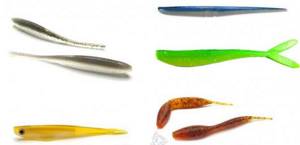
The creature (crocozybra) is not comparable to any inhabitant of the underwater world. Its peculiarity is that it reacts quite actively to various movements. And also the fact that it can move even with the weakest current.
Silicone frogs are mainly used in overgrown areas. Its use is convenient because the hooks are built into it in such a way as not to touch these very thickets. This bait is very good for catching pike. Tubes are very similar in shape to small squids; they have an elongated cylindrical shape with a “fringe” in the tail. Designed for passive fish.
A jig bait, also known as a jig head, is a lead weight of various shapes and weights with a hook. The jig head undoubtedly remains the most effective bait for catching predators.
Foam rubber bait is a bait that imitates the shape of a fish, made of foam rubber, equipped with hooks and a weight. Well suited for catching pike perch.
A spoon is an enamel-coated metal bait (aluminum is used for lightness) that is equipped with a hook. Suitable for both predatory fish found in fresh water bodies and some types of salted fish.
There are several types of spinners: spinner, spinner, unhooked. The oscillating spoon has the simplest design: on an aluminum plate, concave on one side and curved on the other, there are two holes, one for attaching a hook, the other for fishing line. The rotator is an axis, on both sides of which there are winding rings for attaching the fishing line and hook.
There is also a metal plate on it. A rotating spoon under the influence of water resistance creates sound and visual effects. Non-snagging spoons are used for fishing in places where there are thickets. It does not catch on algae due to the antennae located on top of the hook.
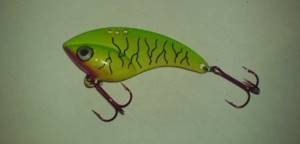
Wobblers resemble fish in their shape. They are equipped with hooks and a blade, which, depending on the shape, allows the wobbler to dive to different depths. Wobblers are made of soft plastic, wood or foam. The most durable design is made of plastic, since the “body” of the wobbler and the blade are cast simultaneously.
Devon is a metal hollow spoon of an elongated shape, at the ends of which there are two blades rotating in opposite directions. Used for catching asp.
A petal with a fly is a cylindrical bait with hairs on the “tail”. In some cases it is equipped with a propeller.
Based on the article, you can see that there is now quite a large selection of artificial baits. And any fisherman, whether amateur or professional, will definitely find something to suit his taste.
